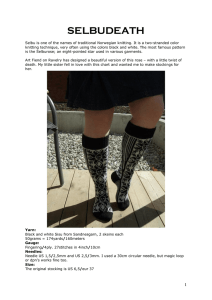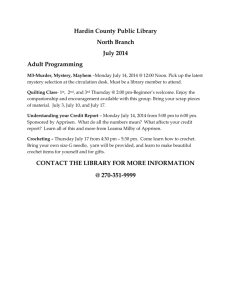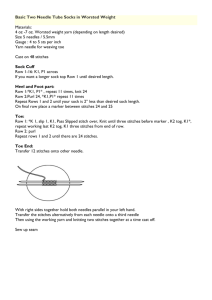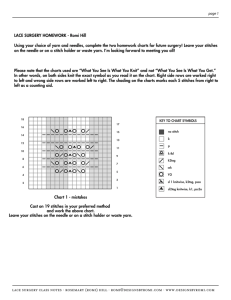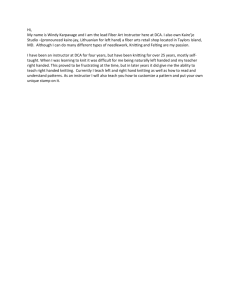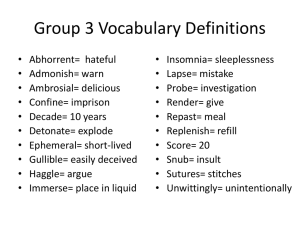Craft, Crafts More Crafts and
advertisement
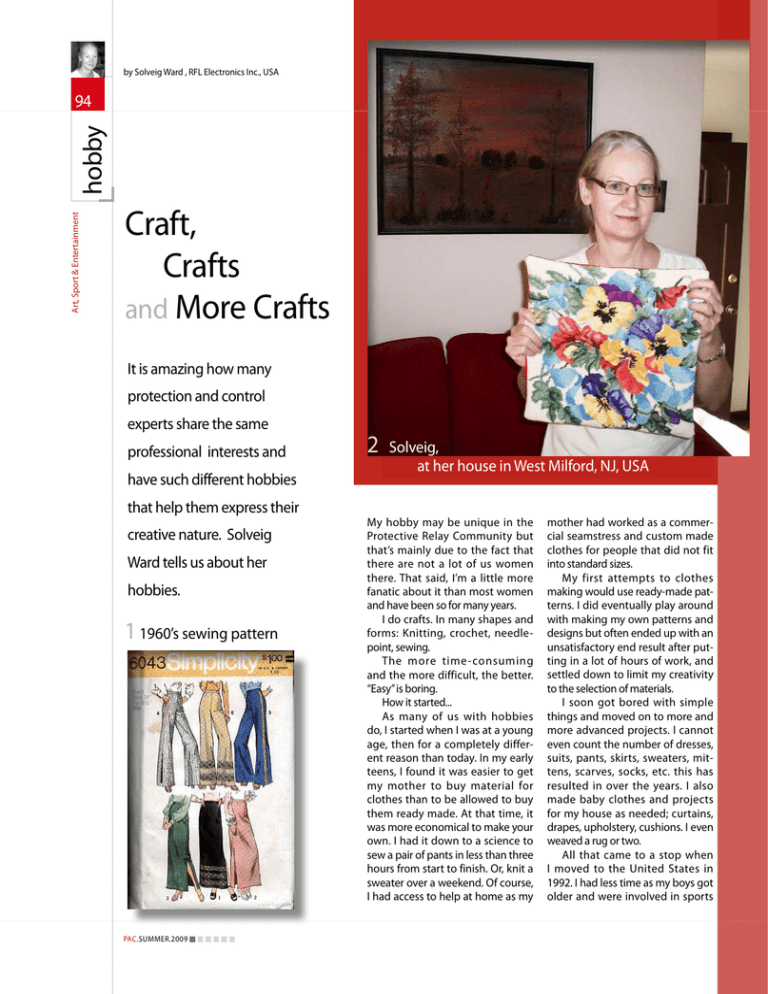
by Solveig Ward , RFL Electronics Inc., USA Art, Sport & Entertainment hobby 94 Craft, Crafts and More Crafts It is amazing how many protection and control experts share the same professional interests and have such different hobbies that help them express their creative nature. Solveig Ward tells us about her hobbies. 1 1960’s sewing pattern PAC.SUMMER.2009 2 Solveig, at her house in West Milford, NJ, USA My hobby may be unique in the Protective Relay Community but that’s mainly due to the fact that there are not a lot of us women there. That said, I’m a little more fanatic about it than most women and have been so for many years. I do crafts. In many shapes and forms: Knitting, crochet, needlepoint, sewing. The more time -consuming and the more difficult, the better. “Easy” is boring. How it started... As many of us with hobbies do, I started when I was at a young age, then for a completely different reason than today. In my early teens, I found it was easier to get my mother to buy material for clothes than to be allowed to buy them ready made. At that time, it was more economical to make your own. I had it down to a science to sew a pair of pants in less than three hours from start to finish. Or, knit a sweater over a weekend. Of course, I had access to help at home as my mother had worked as a commercial seamstress and custom made clothes for people that did not fit into standard sizes. My first attempts to clothes making would use ready-made patterns. I did eventually play around with making my own patterns and designs but often ended up with an unsatisfactory end result after putting in a lot of hours of work, and settled down to limit my creativity to the selection of materials. I soon got bored with simple things and moved on to more and more advanced projects. I cannot even count the number of dresses, suits, pants, skirts, sweaters, mittens, scarves, socks, etc. this has resulted in over the years. I also made baby clothes and projects for my house as needed; curtains, drapes, upholstery, cushions. I even weaved a rug or two. All that came to a stop when I moved to the United States in 1992. I had less time as my boys got older and were involved in sports 95 and other outside school activities. And, there was no longer any economic incentive of doing things yourself. It was much cheaper to buy ready-made. However, the need to create things was still there. I transitioned to basically “useless” projects where I had no need for the end product. Doilies and needlepoint pillows are examples. These were mainly done in front of the TV as I need something in my hands to keep them occupied. Among my most time consuming crafts projects is needlepoint pillows. I never added up the number of hours it takes me to make one, but I would guess around a hundred or perhaps even two hundred. Small, small stitches cover the entire surface. Of course, it is all made by hand. I find it very therapeutic to keep my hands occupied and let my mind wander where it wants to go (Figures 4b & 5). I only have a couple of these pillows still in my house. I always give them away when they are finished. The one in front is in needlepoint, to the left in cross stitch and in the back embroidery (Figure 5). Another time consuming project is to make doilies (Figure 8). I give these away as well as it is not my decorating style to have them in my house. The doilies are crocheted, using a thin thread. They are sometimes my own design but often from a ready-made pattern I like. To follow a pattern is a good way to get introduced to different techniques that I previously didn’t know. Embroidery Embroidery is a free form where different techniques are used for the stitches. The stitches never cover the entire surface. Embroidery items are always my own design while I tend to use ready-made patterns for needlepoint and cross 3 A quick project with enjoyable results, but with less satisfaction I do crafts. The more timeconsuming and the more difficult, the better. “Easy” is boring. stitch. I have transferred my own pictures into needlepoint but it’s a complex procedure that I have not fully mastered yet (Figures 4c & 5). Now, I have to point out that to follow a pattern doesn’t necessarily make it any easier. A crochet pattern can be given as a “road-map” and you have to figure out what all the symbols mean and how they translate into crochet stitches. See Figure 9. Another pattern might provide you with a written instruction. It is a language in its own. It’s not enough to just decode the abbreviations; you also need to know how to execute the stitch it calls for. I recently had to re-learn all this when I picked up a book with doily patterns in English. Needless to say, it was very different from the Swedish “crochet-language” I learned years ago. The “language” also differs from pattern to pattern. See pattern instructions. On occasion, I make a quick project. The shawl displayed in figure 3, was made in less than ten hours as I had a dead line to send it to my mother-in-law for Mother’s Day. While the result was pretty, the satisfaction from these shorter projects is much less than with a time consuming item. The recipient does not always agree with me. My mother-in-law has several of my pillows and doilies that took many, many hours of work but she likes this quick shawl much more. PAC.SUMMER.2009 hobby 96 Knitting, crochet, needlepoint, sewing Knitting While my doilies are crocheted, I always knit sweaters. Knitting results in a thinner material for the same gauge of yarn. The doilies are thin due to the very thin thread used, but that would be extremely time-consuming for a sweater or a cardigan (Figure 6). Knitting is done with two “needles” where the stitches are weaved together, row by row. Simple stitches, like [the one shown in figure 7b], can be made without even looking at the work except for the occasional glance. I often read a book at the same time. See Figure 7a. Crochets Crochet is done with a “hook” where the stitches are added row 4 a by row. Crochet is great for making many different types of stitches, resulting in unique patterns and finishes (Figure 7b). My hobby has been at a rest for a few months thanks to my new kittens. There is nothing kittens like to play with as much as strings and all my crafts projects involve strings. Of course I cannot deny these adorable furballs anything. If they want to play with a string, I let them. No doubt will they lose interest as they grow older and I can resume my unfinished projects. If someone wonders if I make any money on my crafts The answer is no. Just look at what these types of items sell for at for example Ebay. Just a few dollars for something that takes hours and Caesar & Baron, my two Ragdoll cats hours to make. But to make money has never been the purpose. I gladly invest in materials to provide me with many hours of relaxing, creative work. Looking at cost per hour, it is a very cheap hobby. Details from pillows with different techniques used Cross stitch pillow with stitches as an “X” b Needlepoint pillow where the tiny stitches are diagonal and cover the entire surface. 5 Example of three types of pillows As we are so used of seeing commercially made items for a very low price in the stores, it is hard to imagine that anyone would go through the trouble of spending so much time making them themselves. However, then they do not understand the accomplishment you feel when you put the last stitch into a project like this. PAC.SUMMER.2009 b Free form embroidery c 6 Some of my favorite knitted items by Solveig Ward , RFL Electronics Inc., USA 97 About my cats I bought two Ragdolls eight months ago. The Ragdoll is a relatively new US breed (1960’s) known for an easygoing and mellow nature. The name comes from the cat going limp when lifted; it feels like having a ragdoll in your arms. The breed was created from a female Persian and a male Birman, and later a female Burmese. Now, only Ragdoll to Ragdoll breeding takes place. It’s a large breed where males weigh 16-20 pounds when fully grown. Ours are already 11 pounds at 8 months of age. Caesar to the left. He is a flame point and will have orange face, ears and tail when he grows up. Baron on the right. He is a blue point with mittens; gray face, ears, tail and front legs with white paws. It is not an easy task to do any kind of craft, especially knitting when you have not one, but two playful creatures like my Ragdolls. 7 More craft examples: Knitting and single stitches Knitting Single stitches - Crochet a Knitting is done with two “needles” where the stitch- b es are weaved together, row by row. Simple stitches require only one needle and are easier to accomplish. 8 Lace doilies in different shapes and colors Solveig Ward received her M.S.E.E. from the Royal Institute of Technology, Sweden in 1977. The same year she joined ABB Relays. She has held many positions in Marketing, Application, and Product Management. After transferring to ABB in the US 1992, she was involved in numerical distance protection design, and was Product Manager for current differential and phase comparison relays. Solveig holds one patent and has presented several papers. She is a member of IEEE. In June 2002 she joined RFL Electronics Inc. as Director of Product Marketing. 9 A crochet pattern given as a “road-map” Pattern instruction: Rnd 23: (Slip st, work Beginning Cluster) in first ch-2 sp, (ch 2, work Cluster in next ch-2 sp) 4 times, (2 dc, ch 2, 2 dc) in next ch-1 sp, * work Cluster in next ch- 2 sp, (ch 2, work Cluster in next ch-2 sp) 4 times, (2 dc, ch 2, 2 dc) in next ch-1 sp, * around; join with slip st to top of Beggining Cluster: 216 sts and 120 ch ch-2 sps. PAC.SUMMER.2009
